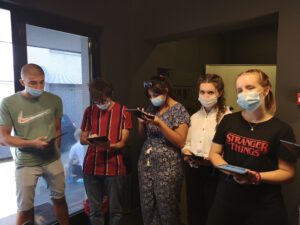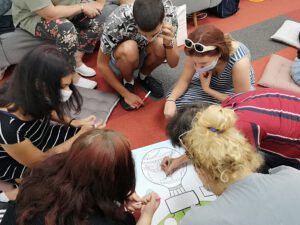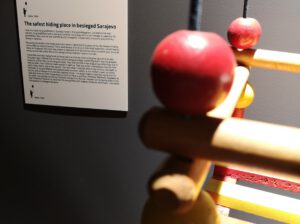(Text: Alma Dzinic-Trutovic) The visit to the museum in the beginnig of August 2021 was initiated by Vlasta Markovic (YU-Peace activist and longtime leader of youth groups) who during a recent private tour of the Museum came up with the idea to invite young people from the Simin Han Youth Club. Thanks to the support of the Committee for Fundamental Rights and Democracy – Vacation from War, the visit could be made possible for 6 cities of the YU-Peace network. It is unbelievable and very commendable that in a very short time (immediately after the camp in Seget Donji, Medena) we gathered a total of 28 young people, including the group leaders from all cities.

The Museum of War Childhood deals with experiences while growing up affected by armed conflict. The museum displays personal items such as diaries, letters, books, clothes and toys, but with each exhibited item there is a story, ie. the memory of its owner connected.
These stories show us from different angles how all armed conflicts can affect childhood: how children and young people then go to school and how they are organized, how and where food and clothes are procured, what are the experiences of those who have to flee their homes, while at the same time it indicates the resilience of children and young people.

As part of the visit to the Museum of War Childhood, a workshop was organized for all participants with the aim of exchanging ideas on ways in which each of us can influence the building of a more peaceful world in the future.
Briefly about the founding of the Museum of War Childhood
The idea of founding the Museum of War Childhood came from the work on a book called „Childhood in War“, which was published in 2013. By asking questions about what childhood in the war was for them, the author of the book, Jasminko Halilović, invited people who were children during the war in Bosnia and Herzegovina to share their experiences. Over 1,000 people responded to this online call in 2010. Many mentioned an object through their answers or attached a photo that reminds them and talks about their wartime childhood. During the collection of answers, Jasminko began to think about what would happen to all these invaluable objects and stories in just a few years, if they are not to be preserved in some way.

Playground in Sarajevo as hidding place
In order for this idea of preserving objects and stories to be realized, a small team of three people was formed that same year. The team grew rapidly, the idea developed and the War Childhood Museum opened in 2017. So far, they have collected over 3,000 exhibits. People who were children during the war „exhibit“ their personal items and explain through the accompanying stories how these items illustrate their experience. These objects and stories tell about the war from a child’s perspective.The goal of Museum is to testify, in addition to trauma and suffering, children’s resilience, and to show how children actively shape their daily lives, despite the difficult circumstances in which they may find themselves.
Since its founding, the museum has expanded its activities to Lebanon, Ukraine, and the United States, making it an international platform that gives voice to children whose childhoods have been affected by the war.
